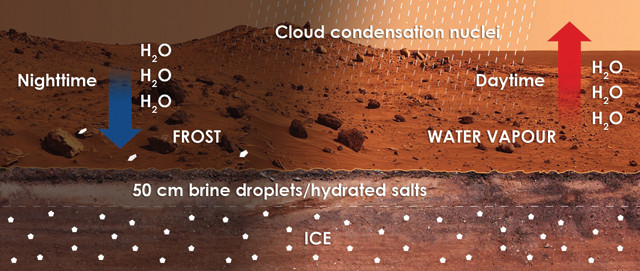
by Timothy Oleson Tuesday, June 16, 2015

Brines might temporarily form just below the surface of Mars through a process called deliquescence when temperatures drop at night. Credit: Martín-Torres and Zorzano.
With two rovers patrolling the surface of Mars, five spacecraft in orbit above it, and scientists here on Earth studying the Red Planet from afar, new findings are announced often. Here are a few of the latest updates.
Briny waters may transiently dampen Martian soils near the planet’s equator, according to a new study in Nature Geoscience that analyzed a year’s worth of observations from the Curiosity rover’s Environmental Monitoring Station. Based on those data, Javier Martín-Torres of the Spanish Research Council and colleagues calculated that brines could form with the help of perchlorate salts known to be present in the soil. The researchers determined that when temperatures on Mars drop at night, the perchlorates could absorb enough water from the atmosphere — through a process called deliquescence — to dissolve into a salty solution that persists until the sun rises again and causes the water to re-evaporate. The potential presence of brines in the shallow subsurface near Mars’ equator — the driest and warmest part of the planet — suggests they could also occur at higher latitudes, where the air carries more moisture. The findings may explain the occurrence of puzzling dark striations occasionally seen on the planet’s surface and thought to result from brief flows of liquid water. They may also be relevant for future exploration missions because perchlorate brines are highly corrosive to both man and machine.
Evidence of “fixed” nitrogen, a necessity for all known life, has been fou time on Mars. After collecting mudstones and windblown dust at different sites in Gale Crater, scientists led by Jennifer Stern of NASA’s Gght Center in Greenbelt, Md., used Curiosity’s instrument suite to analyze gases liberated from the samples as they were heated. Among the compounds detected was nitric oxide, which the team reported was likely a byproduct of the breakdown of nitrate — a biologim of nitrogen. Natural nitrogen fixation on Earth is carried out largely by certain kinds of microbes, but Stern and colleagues noted that the fixed nitrogen on Mars could hd by impact events and volcanic lightning. Nonetheless, they wrote in Proceedings of the National Academy of Sciences, if life did arise on Mars in the distant past when its climate was potentially more hospitable, “it is reasonable to assume that it exploited the available nitrate.”
The MAVEN spacecraft, NASA’s most recent arrival at Mars, observed ultraviolet (UV) aurorae encircling much of the planet’s northern hemisphere for several days last December, scientists reported in March at the Lunar and Planetary Science Conference. Unlike the colorful aurorae on Earth, the UV variety on Mars would have been invisible to most humans. (People with a condition known as aphakia can reportedly see UV light.) According to a NASA press release, the aurorae occurred much deeper in Mars’ atmosphere than they do on Earth, probably because the Red Planet lacks a strong, Earth-like magnetic field to deflect most of the energetic charged particles that stream in from space. The December aurorae are thought to have been caused by a burst of solar electrons, which MAVEN also detected.
Buried midlatitude glaciers on Mars hold enough ice to cover the planet in more than a meter of frozen water, according to a new study in Geophysical Research Letters. Previous studies using data from Mars-orbiting spacecraft had identified numerous glaciers buried beneath layers of debris — thought to shield the ice from evaporation — in the planet’s midlatitude regions. However, the volume of ice contained in these glaciers had not been accurately determined. Now, using radar soundings from the Mars Reconnaissance Orbiter in tandem with ice-flow modeling, Nanna Bjørnholt Karlsson of the University of Copenhagen in Denmark and colleagues calculated the volume of ice in lobate debris aprons — which comprise most of the known midlatitude glacial deposits — to be 155,000 cubic kilometers, or about 5 percent of the volume of the Greenland Ice Sheet.
© 2008-2021. All rights reserved. Any copying, redistribution or retransmission of any of the contents of this service without the expressed written permission of the American Geosciences Institute is expressly prohibited. Click here for all copyright requests.